 I love coster brakes on upright city bicycles and for me this feature is pretty much a must. But I am also aware that not everyone feels the same. So when I am asked whether I think a coaster brake is "better", I can respond only by outlining the pros and cons, as I see them. In short, here is my take on the coaster brake:
I love coster brakes on upright city bicycles and for me this feature is pretty much a must. But I am also aware that not everyone feels the same. So when I am asked whether I think a coaster brake is "better", I can respond only by outlining the pros and cons, as I see them. In short, here is my take on the coaster brake: What is a coaster brake?
What is a coaster brake?A coaster brake is a rear brake on a bicycle that is activated by pedaling backwards. If you want to slow down, simply start to push the pedals backward instead of forward with your feet. The harder you push back, the more braking power is applied. This type of brake is common in upright city bicycles, and it is usually (but not always) supplemented with a front hand-operated brake. The coaster brake is internal and lives in the hub of the rear wheel, rarely requiring maintenance or adjustments.
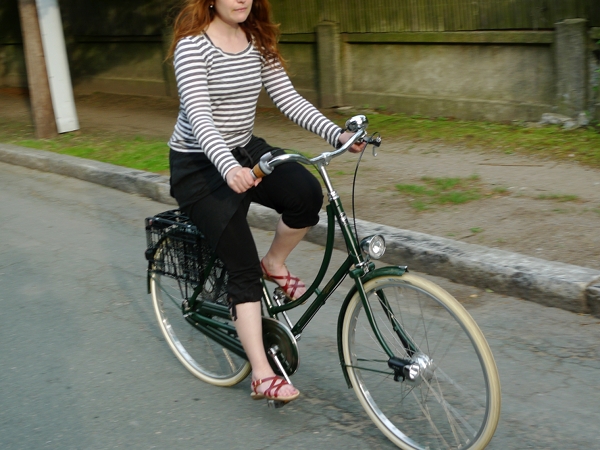 Why I love coaster brakes:
Why I love coaster brakes:. I find that coaster brakes deliver softer (no sudden jolts), smoother, and more consistent stopping power in city traffic
. I like to have one hand free in traffic, so that I can signal while braking
. I find it easier to modulate coaster brakes at finer increments without totally losing momentum
. I have problems with the nerves in my hands, and find it painful to use hand-operated brake levers frequently (like in stop-and-go traffic)
. I find coaster brakes intuitive and stress-free to use: it makes sense to both accelerate and slow down with my feet
. I like it that coaster brakes require virtually zero maintenance or adjustments
Why some dislike coaster brakes:
. They find the act of backpedaling confusing or counterintuitive
. They find it inconvenient that with a coaster brake, you cannot bring the pedal back into starting position in the same way as on a non-coaster brake bike
. They feel that a coaster brake does not provide sufficiently strong braking power
. They lack the leg strength to activate the coaster brake (or have problems with their legs or knees that prevent them from doing so)
I should also add that coaster brakes make sense only on upright city bicycles. Using them on a roadbike would be tricky, because of the speed and the leaned-over position (though I do know of some who have tried, just for fun).
 If you have never tried a coaster brake, there is no way to know whether it's right for you until you test ride a bicycle fitted with one. When I tell anti-coasterbrakites that I love coaster brakes, their response is usually "Oh, but I bet that's because you got used to riding a bike like that when you were a kid." Not true: The first time I tried a coaster brake bicycle was in April . It was love at first backpedal!
If you have never tried a coaster brake, there is no way to know whether it's right for you until you test ride a bicycle fitted with one. When I tell anti-coasterbrakites that I love coaster brakes, their response is usually "Oh, but I bet that's because you got used to riding a bike like that when you were a kid." Not true: The first time I tried a coaster brake bicycle was in April . It was love at first backpedal!How do you feel about coaster brakes, and why? I am sure all feedback will be useful to those wondering about this braking system.
 a few years ago...
a few years ago...
 This bridge used to be the bridge that vehicle traffic used to get from one side of the Rio Grande River to the other side. It is known as the Alameda Bridge. There are several bridges across the river in the Albuquerque area. The Rio Grande Bridge, and the Bernallio Bridge are the oldest. I know they were there in the 1940's but not sure of exact age. The Rio Bravo Bridge was built during the 1960's and the Alameda Bridge I think. I could be wrong on all of these. Probably could have looked up exact dates but I didn't. And the newest one is the Paseo del Norte Bridge which was build in the early 1990's. Of course all except the Paseo Bridge had been rebuild at some point. That is why we were able to walk out on this bridge. The Alameda Bridge was rebuilt in the early 1990's and someone had the good idea of leaving the old bridge for people to walk across on. People on bicycles, horses, and skates can use it, also. Anotherwords non-motorized traffic.
This bridge used to be the bridge that vehicle traffic used to get from one side of the Rio Grande River to the other side. It is known as the Alameda Bridge. There are several bridges across the river in the Albuquerque area. The Rio Grande Bridge, and the Bernallio Bridge are the oldest. I know they were there in the 1940's but not sure of exact age. The Rio Bravo Bridge was built during the 1960's and the Alameda Bridge I think. I could be wrong on all of these. Probably could have looked up exact dates but I didn't. And the newest one is the Paseo del Norte Bridge which was build in the early 1990's. Of course all except the Paseo Bridge had been rebuild at some point. That is why we were able to walk out on this bridge. The Alameda Bridge was rebuilt in the early 1990's and someone had the good idea of leaving the old bridge for people to walk across on. People on bicycles, horses, and skates can use it, also. Anotherwords non-motorized traffic.














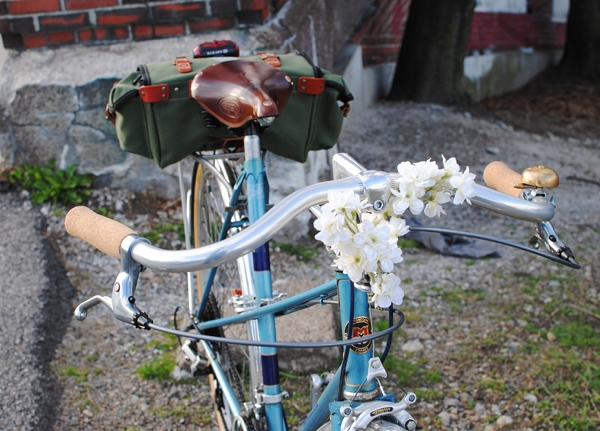 What you see here are upside down Nitto Albatross Bars (Nitto's version of "North Roads").
What you see here are upside down Nitto Albatross Bars (Nitto's version of "North Roads").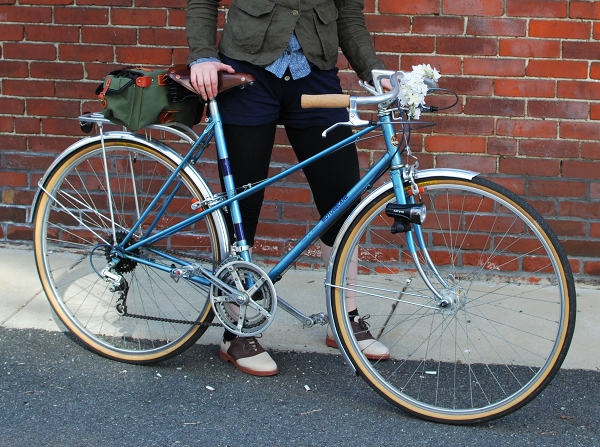 Ever since seeing pictures of vintage path-racers, it has been a fantasy of mine to have this handlebar set-up on one of my bikes. My concern was that it would be too aggressive for me to handle. But since
Ever since seeing pictures of vintage path-racers, it has been a fantasy of mine to have this handlebar set-up on one of my bikes. My concern was that it would be too aggressive for me to handle. But since 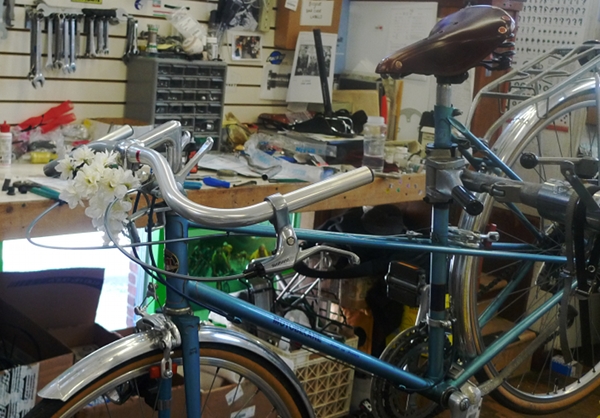 Harris Cyclery had some Albatross bars in stock, and the nice mechanic Jim Ammirato talked to me about installing them upside down. It is so difficult to tell what will feel "too aggressive" to one person versus "comfortable" to another. But luckily one of Jim's own bikes - a gorgeous bordeaux A.N.T. path-racer that deserves its own feature - had this exact set-up. I tried the handlebar position on the A.N.T., and to my amazement it felt wonderful. And so the installation proceeded!
Harris Cyclery had some Albatross bars in stock, and the nice mechanic Jim Ammirato talked to me about installing them upside down. It is so difficult to tell what will feel "too aggressive" to one person versus "comfortable" to another. But luckily one of Jim's own bikes - a gorgeous bordeaux A.N.T. path-racer that deserves its own feature - had this exact set-up. I tried the handlebar position on the A.N.T., and to my amazement it felt wonderful. And so the installation proceeded!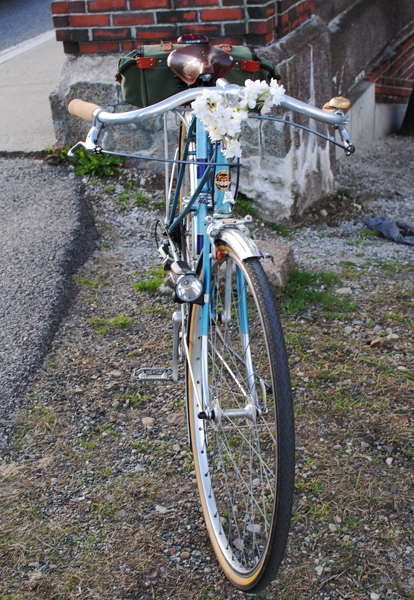 As you can see in the pictures here, installing North Road style handlebars upside down places the hand gripping areas considerably below the level of the stem, while at the same time bringing them closer towards the rider than drop bars. You can control just how far down the gripping areas are by tilting the bar. We made mine on the tamer side to start with, but when I feel ready for a more aggressive posture I will tilt them down further.
As you can see in the pictures here, installing North Road style handlebars upside down places the hand gripping areas considerably below the level of the stem, while at the same time bringing them closer towards the rider than drop bars. You can control just how far down the gripping areas are by tilting the bar. We made mine on the tamer side to start with, but when I feel ready for a more aggressive posture I will tilt them down further.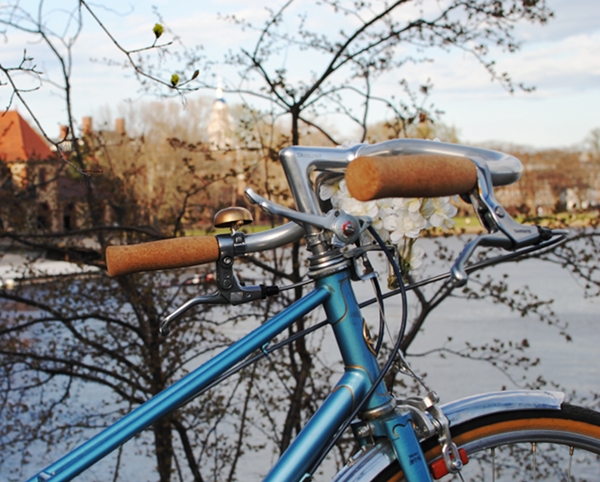 North Roads are famously comfortable, because their gripping areas place the rider's hands in a naturally-occurring position: parallel to the body with an ever so slight outward flare. This is in direct contrast to flat handlebar styles (which includes the flat upper part of the drop bars, where most cyclists really spend most of their time). They position they offer is not a naturally occurring and places stress on the wrists if maintained for long intervals.
North Roads are famously comfortable, because their gripping areas place the rider's hands in a naturally-occurring position: parallel to the body with an ever so slight outward flare. This is in direct contrast to flat handlebar styles (which includes the flat upper part of the drop bars, where most cyclists really spend most of their time). They position they offer is not a naturally occurring and places stress on the wrists if maintained for long intervals.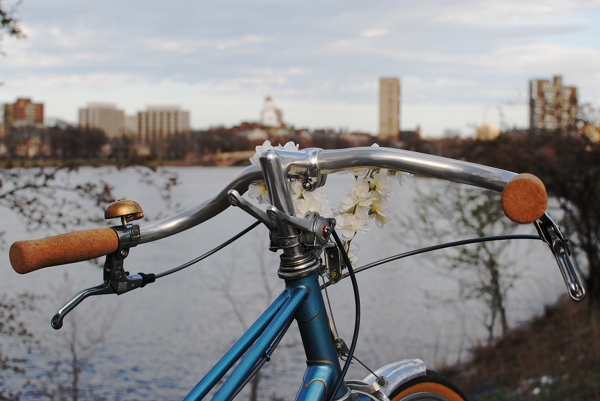 So the cool thing about upside-down North Roads, is that the aggressiveness of the posture is dampened by the comfort of the hand position. If you own an English Roadster or a Dutch bicycle, imagine holding your hands just as you currently hold them, only lower. Not so scary at all.
So the cool thing about upside-down North Roads, is that the aggressiveness of the posture is dampened by the comfort of the hand position. If you own an English Roadster or a Dutch bicycle, imagine holding your hands just as you currently hold them, only lower. Not so scary at all. Perhaps this explains how it is that with the upside-down Albatross bars I am both more leaned over
Perhaps this explains how it is that with the upside-down Albatross bars I am both more leaned over 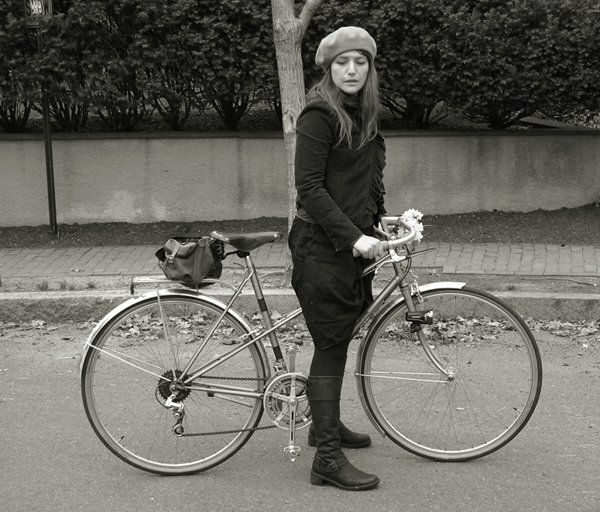 Since these pictures were taken, I have treated the cork grips with wood stain in an attempt to darken them without the slippery finish of shellac. I am still waiting for them to dry and will let you know how this project works out.
Since these pictures were taken, I have treated the cork grips with wood stain in an attempt to darken them without the slippery finish of shellac. I am still waiting for them to dry and will let you know how this project works out.

 these are views from the Gilman Bridge just off the main road going to Jemez Springs. Gilman is an even smaller village. The Jemez Creek flows under the bridge. We stopped to see how well the water was flowing in this time of drought and found it doing ok on this day. I expect it will be really down in a few weeks if we don't get some rain. This water is probably the last of the spring snow melt water.
these are views from the Gilman Bridge just off the main road going to Jemez Springs. Gilman is an even smaller village. The Jemez Creek flows under the bridge. We stopped to see how well the water was flowing in this time of drought and found it doing ok on this day. I expect it will be really down in a few weeks if we don't get some rain. This water is probably the last of the spring snow melt water.



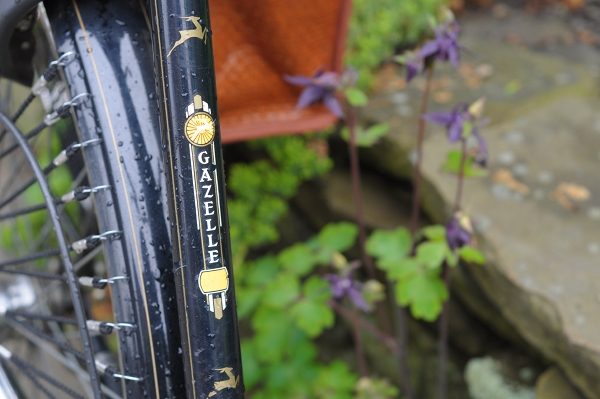 Since Linda began a new life as an outdoor bike, ithas been raining heavily and continuously. I considered bringing the poor bike back inside, but resisted. In her 15 years of life she has probably seen worse. So I left her outdoors as it poured day after day.
Since Linda began a new life as an outdoor bike, ithas been raining heavily and continuously. I considered bringing the poor bike back inside, but resisted. In her 15 years of life she has probably seen worse. So I left her outdoors as it poured day after day.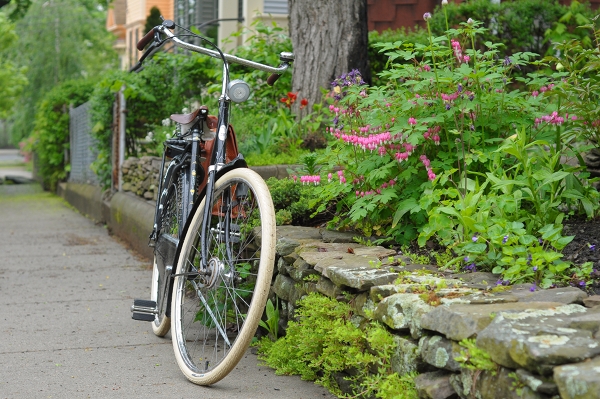 So what's the damage to a Dutch transport bike after two weeks of being left out in the rain? Well, the main thing is that the front brake has developed a shrill squeal. I didn't know that could happen to hub brakes, but apparently it can. The stopping power is the same as before, only now it sounds like a hysterical piglet. The rear coaster brake makes no noise. Should I somehow lubricate the front hub? We are scaring people at intersections!
So what's the damage to a Dutch transport bike after two weeks of being left out in the rain? Well, the main thing is that the front brake has developed a shrill squeal. I didn't know that could happen to hub brakes, but apparently it can. The stopping power is the same as before, only now it sounds like a hysterical piglet. The rear coaster brake makes no noise. Should I somehow lubricate the front hub? We are scaring people at intersections!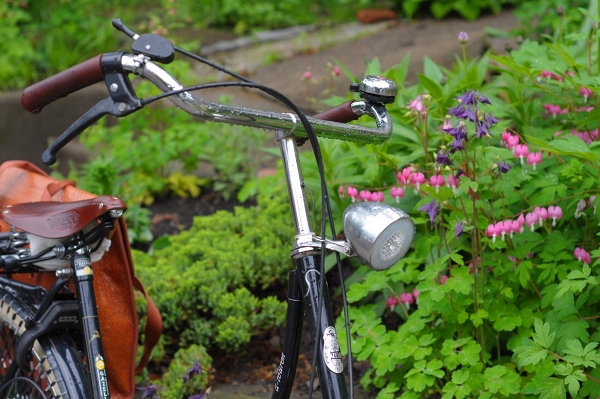 The other thing is that the leather grips are now completely soggy, since, unlike the saddle, I made no provisions to cover them. I installed these gripsin Octoberand they've been rained and snowed on many times with no adverse consequences, so I didn't think it would be a big deal to just leave them uncovered. But of course when it rains non-stop for so many days, it's a different story. Not sure what to do now other than just wait for the sun and let them dry out naturally. But in the future I should try Bobbin and Sprocket's smart solution.
The other thing is that the leather grips are now completely soggy, since, unlike the saddle, I made no provisions to cover them. I installed these gripsin Octoberand they've been rained and snowed on many times with no adverse consequences, so I didn't think it would be a big deal to just leave them uncovered. But of course when it rains non-stop for so many days, it's a different story. Not sure what to do now other than just wait for the sun and let them dry out naturally. But in the future I should try Bobbin and Sprocket's smart solution.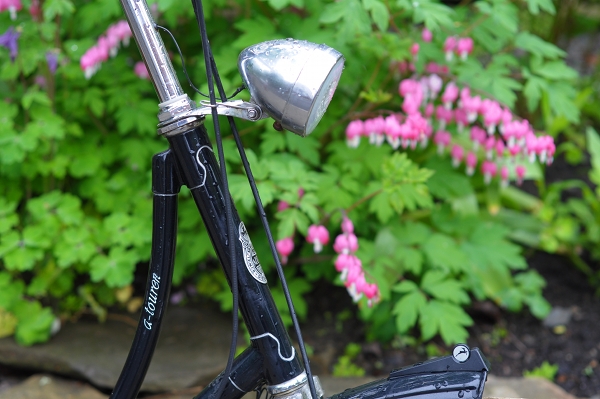 Otherwise, nothing on the bike seems any worse for wear. I am especially pleased that my silver lug-lining (done with a Sharpie!)has held up and that the bottle dynamo isunaffected. Now if only it would stop raining!
Otherwise, nothing on the bike seems any worse for wear. I am especially pleased that my silver lug-lining (done with a Sharpie!)has held up and that the bottle dynamo isunaffected. Now if only it would stop raining!
 Cumberland Island National Seashore, St. Marys, Georgia
Cumberland Island National Seashore, St. Marys, Georgia